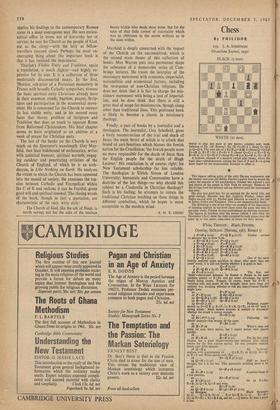Chess
By PHILIDOR
259. J. A. SCHIFFMAN (Grantham Journal, 1930)
BLACK (9 men) WHITE (io men)
wfirra to play and mate in two moves solution next week. Solution to No. 258 (Reeves): Kt. (K 7)-Kt 6 I, threat Q-Q 3 or Q-Q 6. The tries are (a) x Ke(B 4)-M6 I? (threat:Q-01 6 or Kt-B 5), RxP I (b) I P-Kt 6 I? (threat Q-Q 3 or Kt-B 6), B-K 6! (c) i Q-Kt 6 l? (threat Kt-B 5 or Kt-B 6), Kt-B 51 A brilliant example of a modern virtual play theme, where the basic idea-simultaneously cutting the lines of B and R-is given more depth by the unsuccessful attempts to effect it.
The biggest talking point of the 1965 Havana tournament was the twenty-two-year-old Bobby Fischer-partly how he would do, partly the manner of his participation. Fischer was refused a visa and played all his games in New York by teletype. However, he did at least have his military call-up deferred until the tournament was over. His play was good but, for an aspirant for the world title, not good enough. Smyslov was first 054/20, Fischer, Ivkov and Geller second with r5; Fischer beat Smyslov in round 2, but lost to Ivkov, Geller and Kholmov. This is not championship form. The following is one of his wins-an example of the importance of opening analysis in top-level chess since the game was won in pre-play study, Fischer having undermined an existing variation. The figures in brackets after the moves (which I take from the November Chess) show the time occupied by each player over the game up to that point; time-limit 21 hours for forty moves.
White, TRINGOV. Black, FISCHER. Opening, SICILIAN. (Havana, 1965. Round 5) • P-K (o.00) P-Q B ¢ (0.17) Fischer arrived zy minutes late in New York.
• Kt-K B 3 (0.01) P-Q (0.17) 3 P-Q 4 (o.ot) P X P (0.17) 5 Kt-Q B 3 0.04) P-2. R 048) 6 B-K Kt 5 0.07) P- K3 (0.19)
4 Kt X.P (O.03? Kt-K B 3 (0.18) 7 P-B 4 (0.08) Q-Kt 3 (o.19) 8 Q-Q 2 (0.12) . - One of the most heavily analysed pawn sacrifices in chess: after more than ten years' study, it is still not known whether it is good or bad.
9 it-gt Kt z (0,8) 3-R 6 (o.19) ro 8 . . . x P (o.19)
P-K 5 (o.5o) . . . The first real `think'-thirty-two minutes. In Round 7, Parma in the same position played 10 B x Kt and got some advantage, the game finally being drawn. Tringov, of course, knew the P-K 5 variation well, and much of his thought must have been not analysis but deciding whether to risk any improvement Fischer might have.
10 . • PxP (o.19) xx P xP (o.52) K Kt--Q 2 (0.19)
B-Q B 4 (o.$6) B-Kt 5 (o.2o) 73 R-Kt 3 (x.xt) Q-R 4 (o.2o)
14 0-0 (t.t8). . . Pitchman recom- mends 14 R 3, B xP; 15 R xB, Q x R; 0-0 'with a strong attack.' More master practice is needed to determine whether the attack is strong enough. Li • • • 0-0 (o.24)
15 Kt x Ph' (5.24) • • • chives' analysis-but wrong, all the same. P x Kt (0.38)
z6 B x P ch . . . White's time not given for next three moves, but I expect moves were played quickly. ,
• . .. K-R lt (0.29)
77 RxR ch BxR (o.51) For the first time Fischer has a good think-twenty-two minutes after taking twelve for the first sixteen moves. He was probably making finally sure of his analysis. ▪ Q-B 4 • • • All 'Archives' analysis with continuation 18. . But x K P; 19 Q x Q, Kt x Q;
20 B: and White stands well. But . . .
18 . . . Kt-Q B 3: (0.53)
tg Q-B 7 (1,57) • • • Half an hour's i thought, but it is too late. This apparently crushing move is no good.
Q-B 4 ch (0.54
20 K-R t (2.14) • • • A useless think in a lost position.
Kt-B 31 (0.54)
2.t Bx.13 (2.15) . . . Or 21 P x ICE, B x B; 22 QxB, QxB and wins.
Kt x P (o.59) 22 Q-1(45 (2.15) Kt (4)-Kt sl (Loa)
.23 Resigns . . . Black threatens (a) 23.K _.. Q.)(Q B, (b) 23 , . R or Q x B, (0) 23' . . Kt-B 7 ch; 24-Kt Kt-.11. 6 ch. and 25 , Q mates, At least a piece is lost.
Following `Ar•






































 Previous page
Previous page